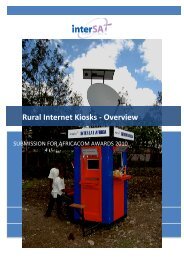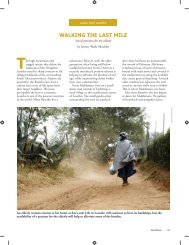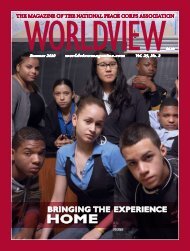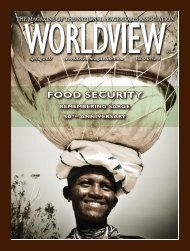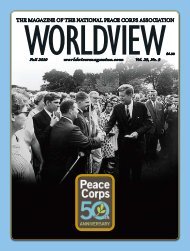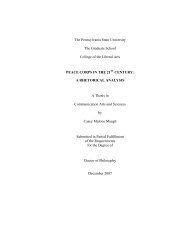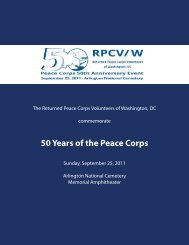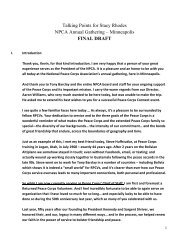Group Education Manual - Peace Corps Wiki
Group Education Manual - Peace Corps Wiki
Group Education Manual - Peace Corps Wiki
You also want an ePaper? Increase the reach of your titles
YUMPU automatically turns print PDFs into web optimized ePapers that Google loves.
contribute to, and benefit from, all spheres of society (economic, political, social, cultural). In this way, genderequity leads to gender equality. For example, an affirmative action policy that promotes increased support tofemale-owned businesses can be considered gender equitable because it leads to ensuring equal rightsbetween men and women.(2) Gender Specificity: Looking at the specific needs that men have in terms of their health and developmentbecause of the way they are socialized. This means, for example, engaging men in discussions aboutsubstance use or risky behavior and helping them understand why they may feel pressured to behave in thoseways.This manual attempts to incorporate these two perspectives. 4Men and HIV/AIDSWorldwide, the behavior of many adult and adolescent men puts them and their partners at risk for HIV. Onaverage, men have more sexual partners than women. HIV is more easily transmitted sexually from man towoman than from woman to man. An HIV-infected man is likely to infect more persons than an HIVinfectedwoman. Engaging men more extensively in HIV prevention has a tremendous potential to reducewomen’s risk for HIV.In many other parts of the world, it is young and adult men who largely control when and under whatcircumstances sex will take place and whether a contraceptive method will be used. For many men worldwide,sexual experience is frequently associated with initiation into manhood. 5 Men may experience peer pressure tobe sexually active and have multiple partners in order to prove that they are manly, which increases their riskof exposure to HIV. Recent data indicate that new HIV infections in high-prevalence countries often occuras a result of concurrent or overlapping sexual partnerships. 6 Research has shown that in both urban andrural areas, young men who choose to abstain may suffer ridicule from their peers. 7,8 Accordingly, low levelsof consistent condom use among sexually active men are associated with a variety of factors, including lowself-risk perception, lack of, or limited access to, condoms, and the belief that unprotected sex is morepleasurable and that pregnancy is proof of masculinity and fertility.It is also important to address men’s use of violence and coercion in sexual relationships and its associationwith gender norms and risk behaviors. Research has shown that some men may consider the use of violenceagainst women to be an extension of male authority in the private realm and an acceptable means of controlor discipline, particularly in married and long-term relationships. 9,10 Moreover, research has shown that manymen may hold narrow views of what can be defined as “forced sex.” That is, they may believe that onlycoerced intercourse would be categorized as forced sex, and that it is acceptable to use physical violence orgifts to “persuade” partners to have sex. 11 All forms of violence and coercion, however, reinforce unequal4 In this manual, for the sake of brevity, when referring to work with men, we are including all work with boys, young men, and adultmen.5 Wight, D., et al. 2005. Contradictory sexual norms and expectations for young people in rural Northern Tanzania. Social Science &Medicine 62: 987–997.6 Hayes, R. et H. Weiss. 2006. Understanding HIV epidemic trends in Africa. Science Feb3:311(5761):620-17.7 Ijumba, A., et al. 2006. Developing community-based behavior change communications (BCC) interventions for youth: a participatory assessment inIringa region, Tanzania. Arlington, VA: Family Health International.8 Wight, D., et al. 2005. Contradictory sexual norms and expectations for young people in rural Northern Tanzania. Social Science &Medicine 62:987-97.9 Heidi, L., et al. 2004. Exploring the association between HIV and violence: young people’s experiences with infidelity, violence andforced sex in Dar es Salaam, Tanzania. International Family Planning Perspectives 30(4):200–206.10 Barker, G. and Ricardo, C. 2005. Young men and the construction of masculinity in Sub-Saharan Africa: implications for HIV/AIDS, conflict andviolence. Washington, DC: World Bank.11 Heidi, L., et al. 2004. Exploring the association between HIV and violence: young people’s experiences with infidelity, violence, andforced sex in Dar es Salaam, Tanzania. International Family Planning Perspectives 30(4):200–206.6




